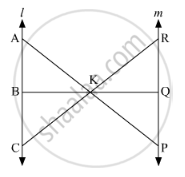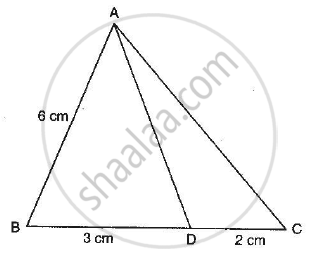Advertisements
Advertisements
प्रश्न
ABCD is a trapezium such that BC || AD and AD = 4 cm. If the diagonals AC and BD intersect at O such that \[\frac{AO}{OC} = \frac{DO}{OB} = \frac{1}{2}\], then BC =
विकल्प
7 cm
8 cm
9 cm
6 cm
उत्तर
Given: ABCD is a trapezium in which BC||AD and AD = 4 cm
The diagonals AC and BD intersect at O such that `(AO)/(OC)=(DO)/(OB)=1/2`
To find: DC

In ΔAOD and ΔCOB
\[\angle ODA = \angle OBC \left( \text{Alternate angles} \right)\]
\[\angle AOD = \angle BOC \left( \text{Vertically opposite angles} \right)\]
\[So, ∆ AOD~ ∆ COB \left( \text{AAA similarity} \right)\]
\[\text{Now, correponding sides of similar ∆ 's are proportional} . \]
\[\frac{AO}{CO} = \frac{DO}{BO} = \frac{AD}{BC}\]
\[ \Rightarrow \frac{1}{2} = \frac{AD}{BC}\]
\[ \Rightarrow \frac{1}{2} = \frac{4}{BC}\]
\[ \Rightarrow BC = 8 cm\]
Hence the correct answer is `b`
APPEARS IN
संबंधित प्रश्न
In the given figure, DE || BD. Determine AC and AE.

In ∆ABC, P and Q are points on sides AB and AC respectively such that PQ || BC. If AP = 4 cm, PB = 6 cm and PQ = 3 cm, determine BC.
In the given figure, l || m
(i) Name three pairs of similar triangles with proper correspondence; write similarities.
(ii) Prove that

Nazima is fly fishing in a stream. The tip of her fishing rod is 1.8 m above the surface of the water and the fly at the end of the string rests on the water 3.6 m away and 2.4 m from a point directly under the tip of the road. Assuming that her string (from the tip of her road to the fly) is taut, how much string does she have out (in the given figure)? If she pulls the string at the rate of 5 cm per second, what will the horizontal distance of the fly from her after 12 seconds.

In the adjoining figure, if AD is the bisector of ∠A, what is AC?

The areas of two similar triangles are 169 cm2 and 121 cm2 respectively. If the longest side of the larger triangle is 26 cm, what is the length of the longest side of the smaller triangle?
In triangles ABC and DEF, ∠A = ∠E = 40°, AB : ED = AC : EF and ∠F = 65°, then ∠B =
∆ABC ∼ ∆PQR such that ar(∆ABC) = 4 ar(∆PQR). If BC = 12 cm, then QR =
If in two triangle ABC and DEF, ∠A = ∠E, ∠B = ∠F, then which of the following is not true?
(a)\[\frac{BC}{DF} = \frac{AC}{DE}\]
(b)\[\frac{AB}{DE} = \frac{BC}{DF}\]
(c)\[\frac{AB}{EF} = \frac{AC}{DE}\]
(d)\[\frac{BC}{DF} = \frac{AB}{EF}\]
If E is a point on side CA of an equilateral triangle ABC such that BE ⊥ CA, then AB2 + BC2 + CA2 =
